TOYOTA RAV4 EV 2014 1.G Manual PDF
Manufacturer: TOYOTA, Model Year: 2014, Model line: RAV4 EV, Model: TOYOTA RAV4 EV 2014 1.GPages: 521, PDF Size: 7.44 MB
Page 71 of 521
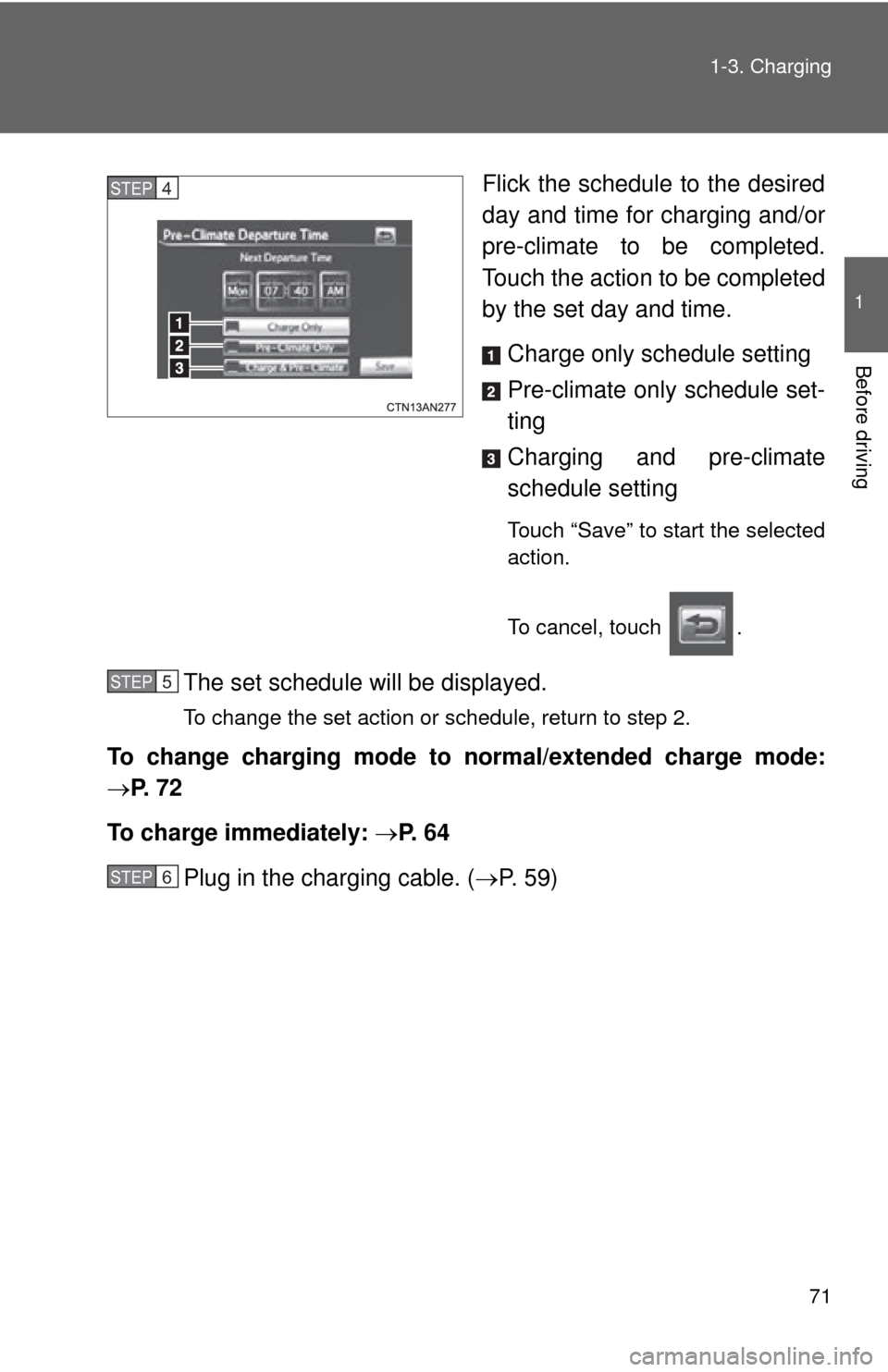
71
1-3. Charging
1
Before driving
Flick the schedule to the desired
day and time for charging and/or
pre-climate to be completed.
Touch the action to be completed
by the set day and time.
Charge only schedule setting
Pre-climate only schedule set-
ting
Charging and pre-climate
schedule setting
Touch “Save” to start the selected
action.
To cancel, touch .
The set schedule will be displayed.
To change the set action or schedule, return to step 2.
To change charging mode to normal/extended charge mode:
P. 7 2
To charge immediately: P. 6 4
Plug in the charging cable. ( P. 59)
STEP 4
STEP 5
STEP 6
Page 72 of 521
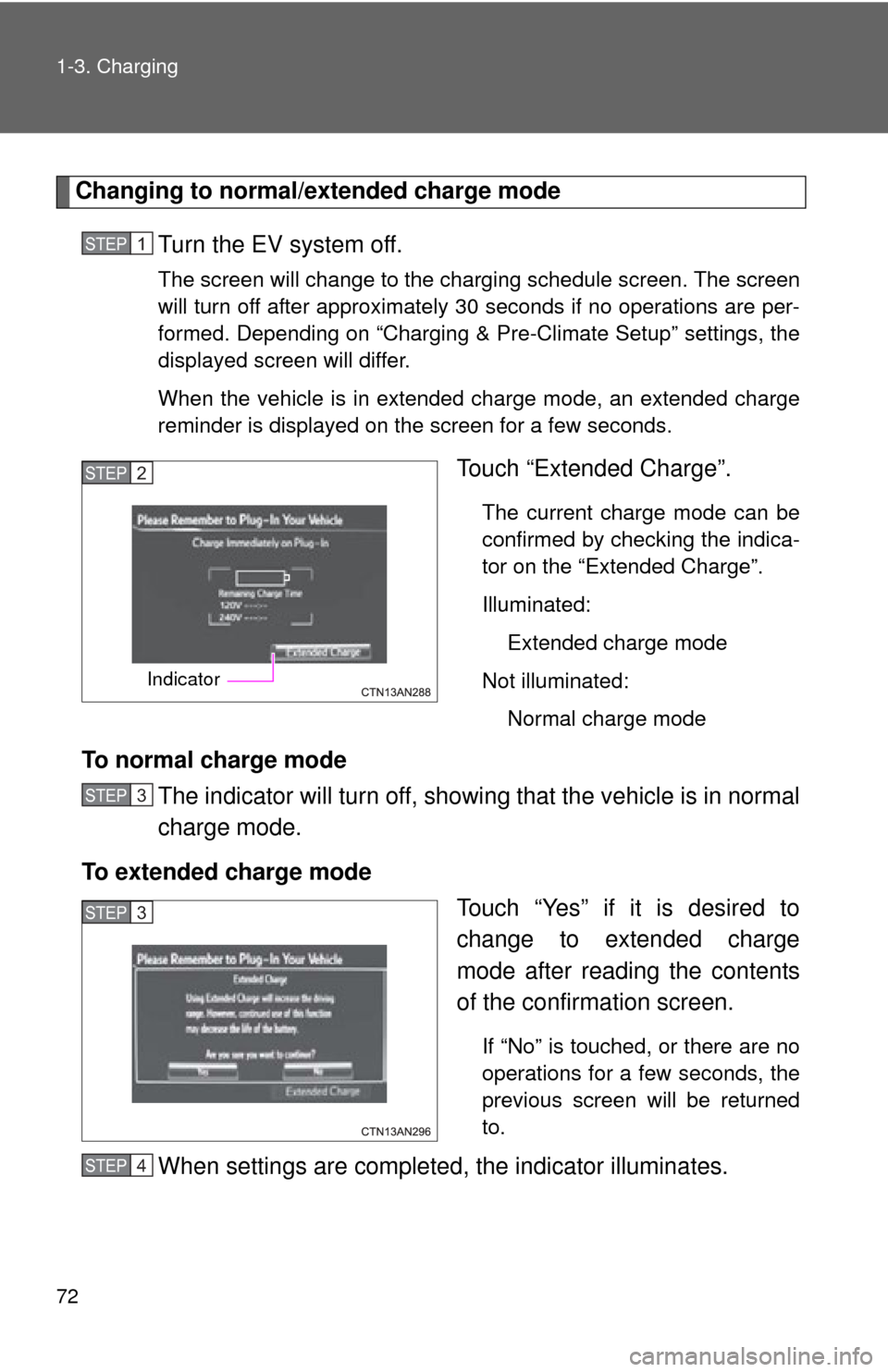
72 1-3. Charging
Changing to normal/extended charge modeTurn the EV system off.
The screen will change to the charging schedule screen. The screen
will turn off after approximately 30 seconds if no operations are per-
formed. Depending on “Charging & Pre-Climate Setup” settings, the
displayed screen will differ.
When the vehicle is in extended charge mode, an extended charge
reminder is displayed on the screen for a few seconds.
Touch “Extended Charge”.
The current charge mode can be
confirmed by checking the indica-
tor on the “Extended Charge”.
Illuminated:Extended charge mode
Not illuminated: Normal charge mode
To normal charge mode The indicator will turn off, show ing that the vehicle is in normal
charge mode.
To extended charge mode Touch “Yes” if it is desired to
change to extended charge
mode after reading the contents
of the confirmation screen.
If “No” is touched, or there are no
operations for a few seconds, the
previous screen will be returned
to.
When settings are completed, the indicator illuminates.
STEP 1
STEP 2
Indicator
STEP 3
STEP 3
STEP 4
Page 73 of 521
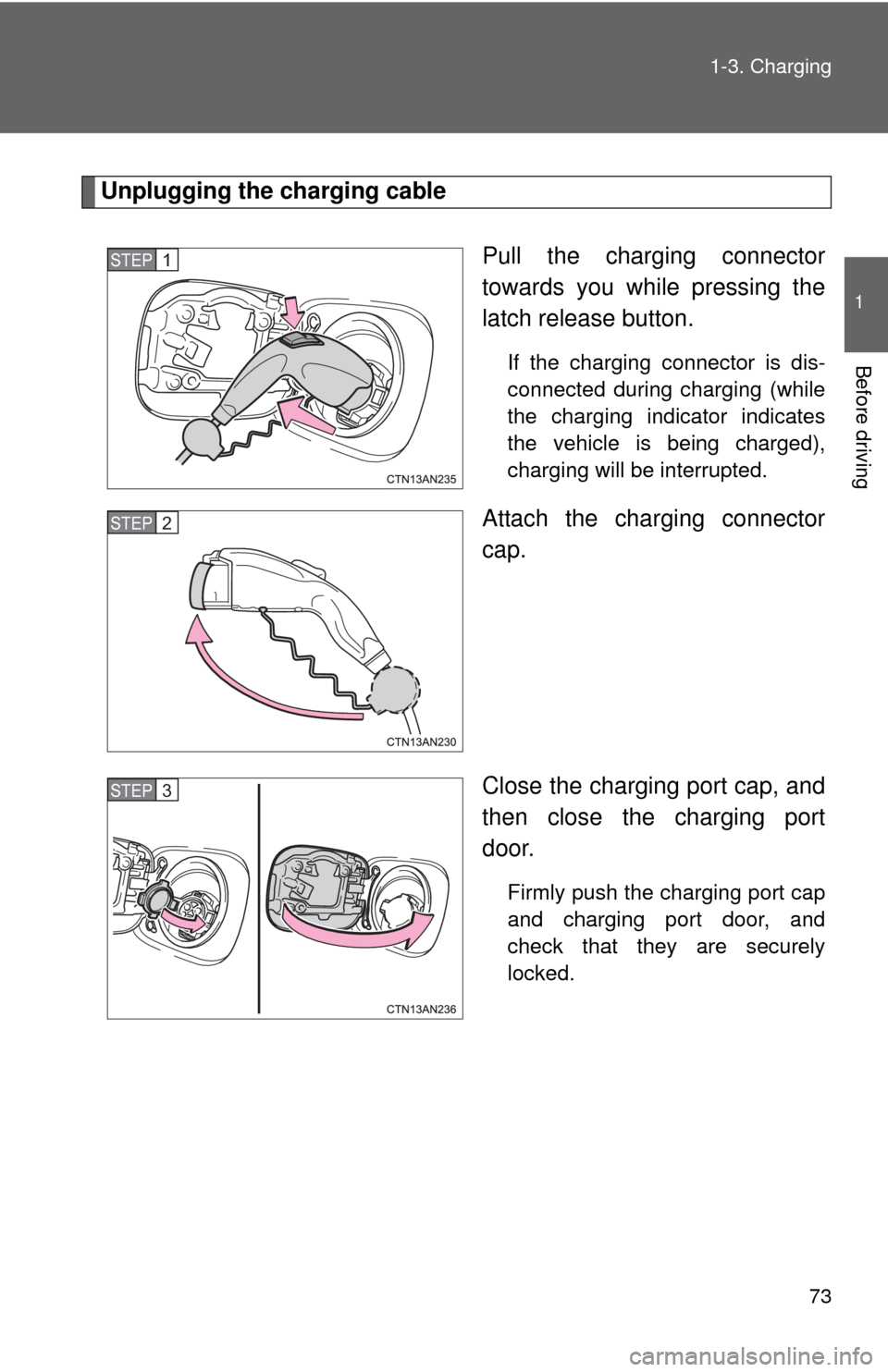
73
1-3. Charging
1
Before driving
Unplugging the charging cable
Pull the charging connector
towards you while pressing the
latch release button.
If the charging connector is dis-
connected during charging (while
the charging indicator indicates
the vehicle is being charged),
charging will be interrupted.
Attach the charging connector
cap.
Close the charging port cap, and
then close the charging port
door.
Firmly push the charging port cap
and charging port door, and
check that they are securely
locked.
STEP 1
STEP 2
STEP 3
Page 74 of 521
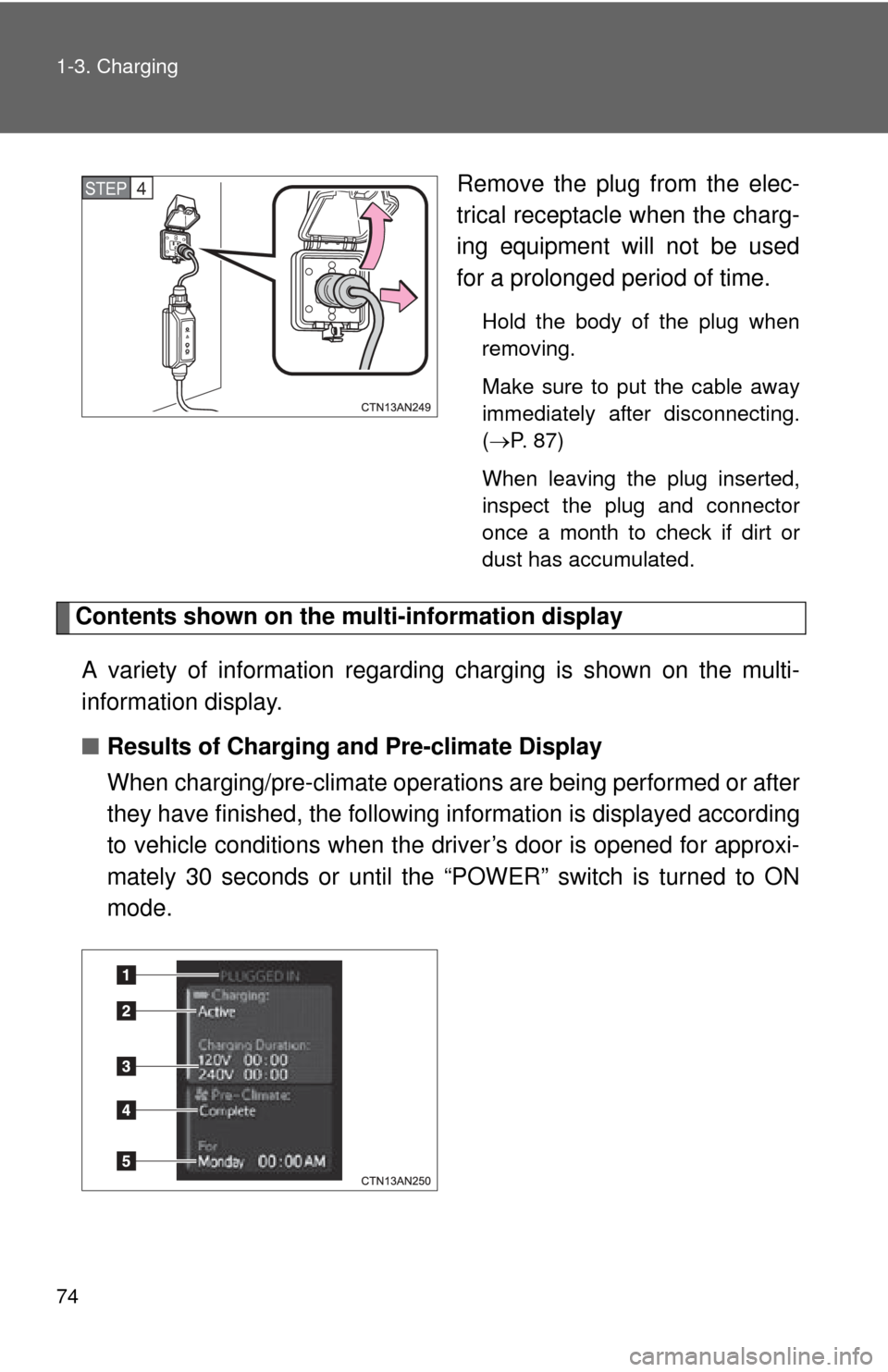
74 1-3. Charging
Remove the plug from the elec-
trical receptacle when the charg-
ing equipment will not be used
for a prolonged period of time.
Hold the body of the plug when
removing.
Make sure to put the cable away
immediately after disconnecting.
(P. 87)
When leaving the plug inserted,
inspect the plug and connector
once a month to check if dirt or
dust has accumulated.
Contents shown on the multi-information display
A variety of information regarding charging is shown on the multi-
information display.
■ Results of Charging and Pre-climate Display
When charging/pre-climate operations are being performed or after
they have finished, the following information is displayed according
to vehicle conditions when the driver’s door is opened for approxi-
mately 30 seconds or until the “POWER” switch is turned to ON
mode.
STEP 4
Page 75 of 521
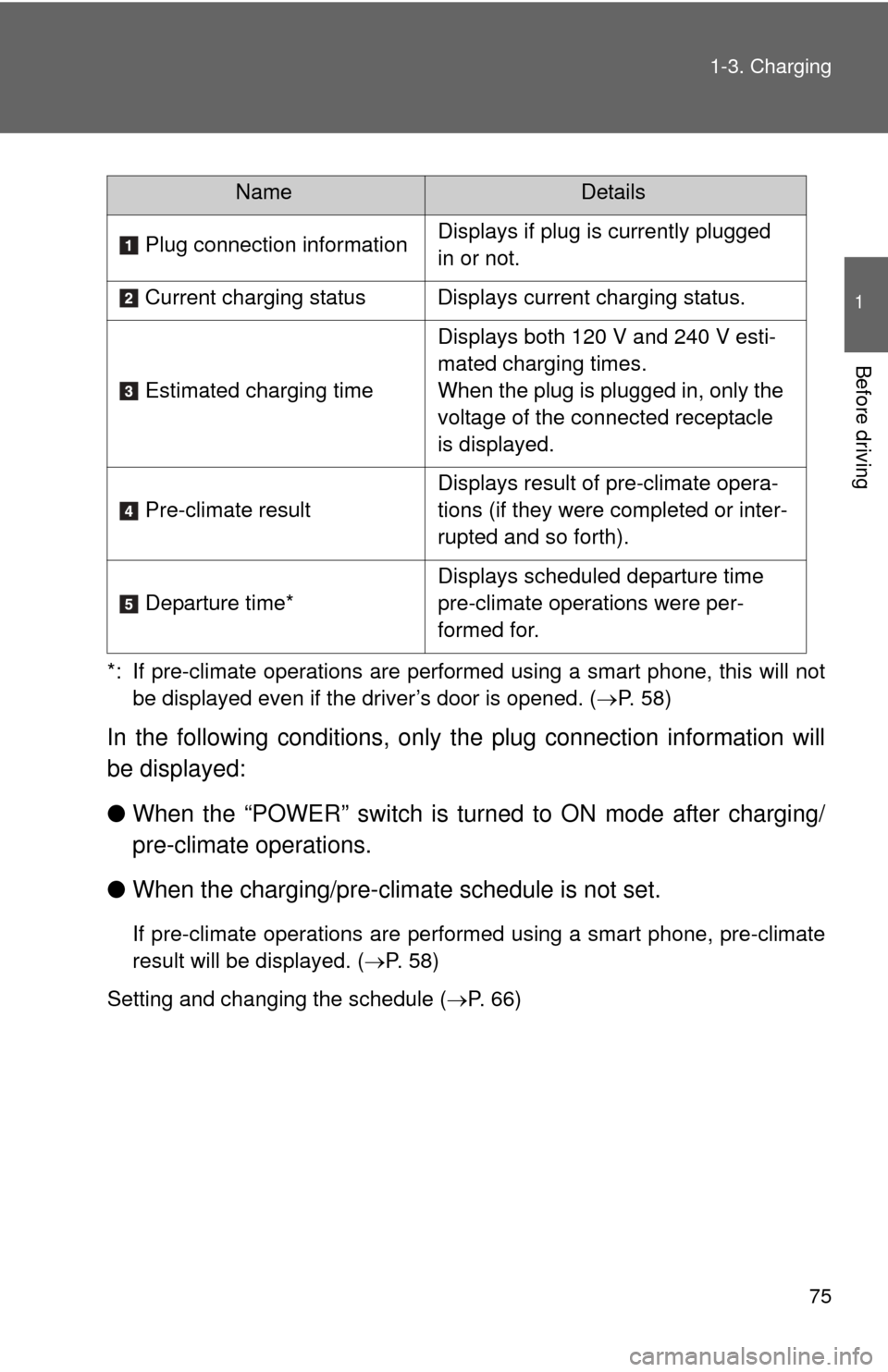
75
1-3. Charging
1
Before driving
*: If pre-climate operations are performed using a smart phone, this will not
be displayed even if the driver’s door is opened. ( P. 58)
In the following conditions, only the plug connection information will
be displayed:
● When the “POWER” switch is turned to ON mode after charging/
pre-climate operations.
● When the charging/pre-clim ate schedule is not set.
If pre-climate operations are performed using a smart phone, pre-climate
result will be displayed. (P. 58)
Setting and changing the schedule ( P. 66)
NameDetails
Plug connection information Displays if plug is currently plugged
in or not.
Current charging status Displays current charging status.
Estimated charging time Displays both 120 V and 240 V esti-
mated charging times.
When the plug is plugged in, only the
voltage of the connected receptacle
is displayed.
Pre-climate result Displays result of pre-climate opera-
tions (if they were completed or inter-
rupted and so forth).
Departure time* Displays scheduled departure time
pre-climate operations were per-
formed for.
Page 76 of 521
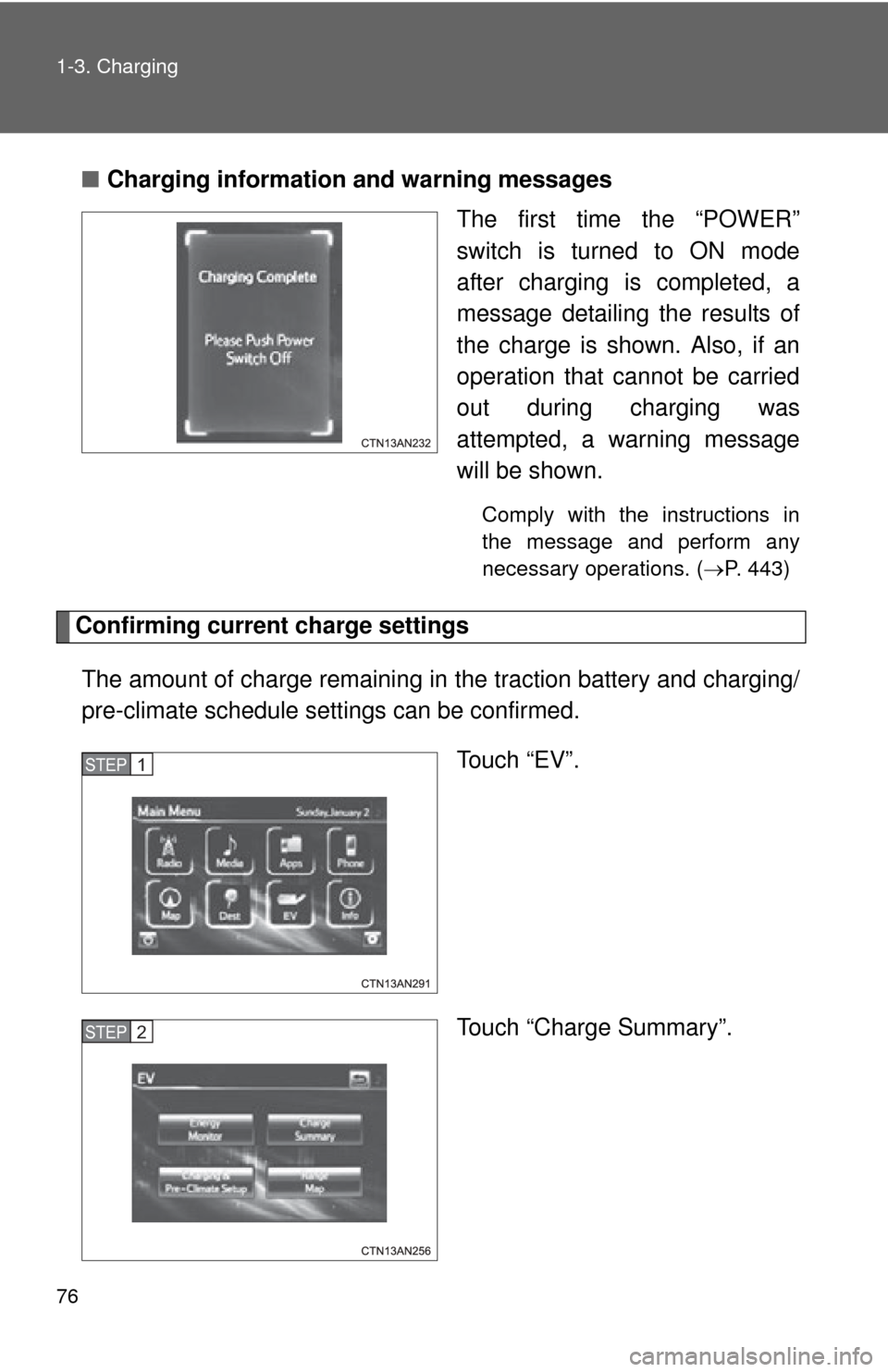
76 1-3. Charging
■Charging information and warning messages
The first time the “POWER”
switch is turned to ON mode
after charging is completed, a
message detailing the results of
the charge is shown. Also, if an
operation that cannot be carried
out during charging was
attempted, a warning message
will be shown.
Comply with the instructions in
the message and perform any
necessary operations. (P. 443)
Confirming current charge settings
The amount of charge remaining in the traction battery and charging/
pre-climate schedule sett ings can be confirmed.
Touch “EV”.
Touch “Charge Summary”.
STEP 1
STEP 2
Page 77 of 521
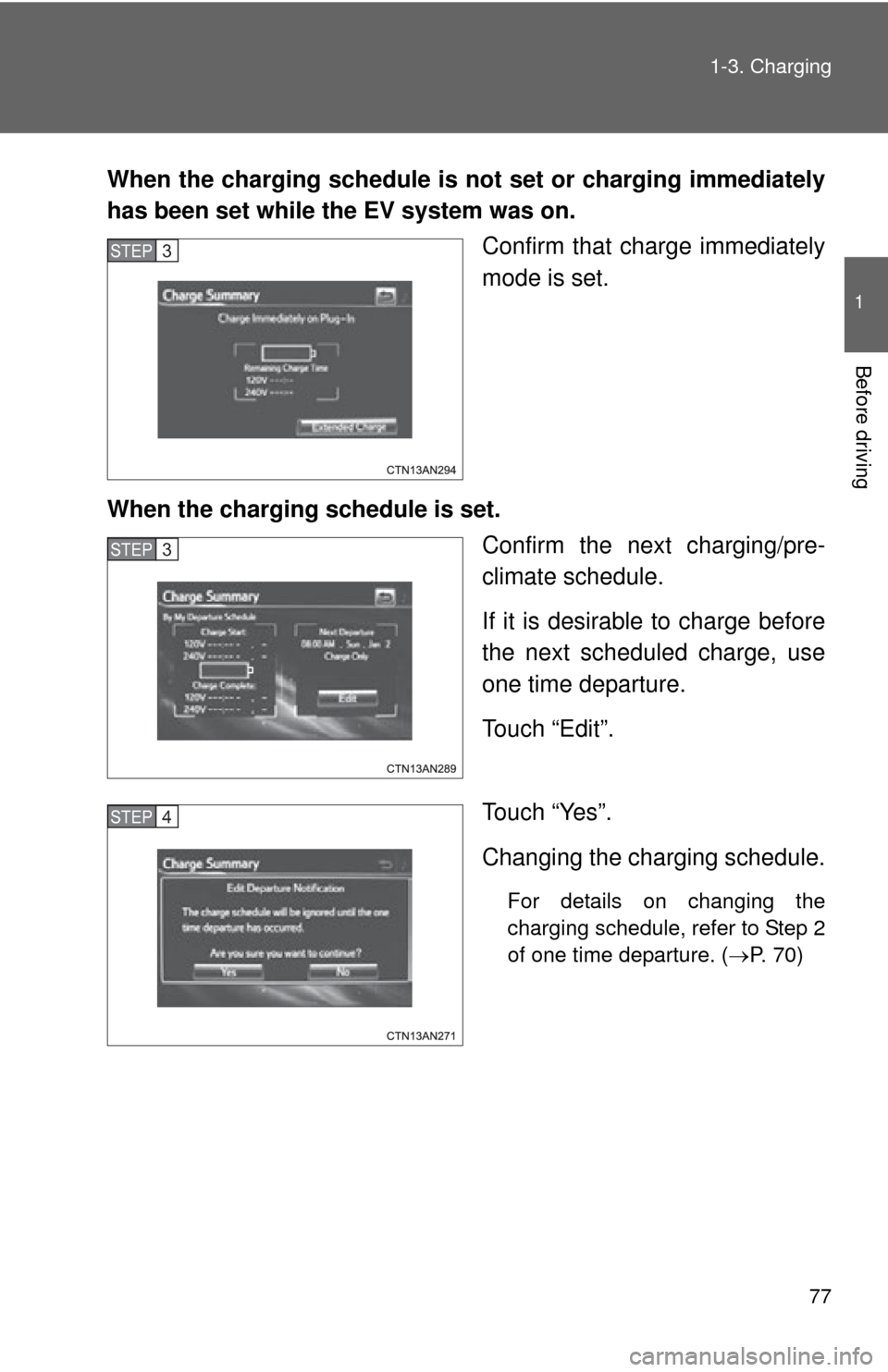
77
1-3. Charging
1
Before driving
When the charging schedule is not
set or charging immediately
has been set while the EV system was on.
Confirm that charge immediately
mode is set.
When the charging schedule is set. Confirm the next charging/pre-
climate schedule.
If it is desirable to charge before
the next scheduled charge, use
one time departure.
Touch “Edit”.
Touch “Yes”.
Changing the charging schedule.
For details on changing the
charging schedule, refer to Step 2
of one time departure. (P. 70)
STEP 3
STEP 3
STEP 4
Page 78 of 521
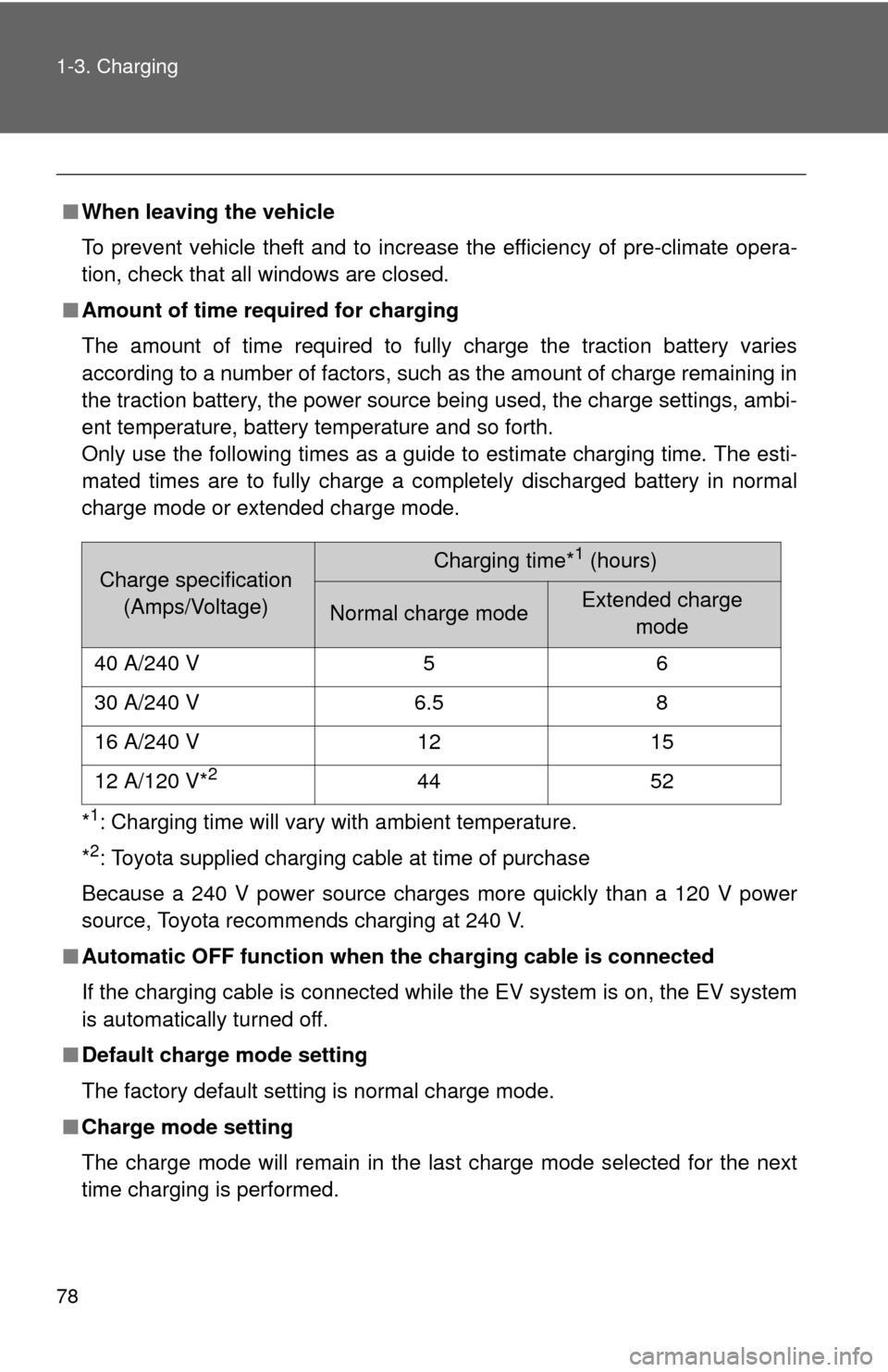
78 1-3. Charging
■When leaving the vehicle
To prevent vehicle theft and to increase the efficiency of pre-climate opera-
tion, check that all windows are closed.
■ Amount of time required for charging
The amount of time required to fully charge the traction battery varies
according to a number of factors, such as the amount of charge remaining in
the traction battery, the power source being used, the charge settings, ambi-
ent temperature, battery temperature and so forth.
Only use the following times as a guide to estimate charging time. The esti-
mated times are to fully charge a completely discharged battery in normal
charge mode or extended charge mode.
*
1: Charging time will vary with ambient temperature.
*
2: Toyota supplied charging cable at time of purchase
Because a 240 V power source charges more quickly than a 120 V power
source, Toyota recommends charging at 240 V.
■ Automatic OFF function when th e charging cable is connected
If the charging cable is connected while the EV system is on, the EV system
is automatically turned off.
■ Default charge mode setting
The factory default setting is normal charge mode.
■ Charge mode setting
The charge mode will remain in the last charge mode selected for the next
time charging is performed.
Charge specification
(Amps/Voltage)Charging time*1 (hours)
Normal charge mode Extended charge mode
40 A/240 V 5 6
30 A/240 V 6.5 8
16 A/240 V 12 15
12 A/120 V*
244 52
Page 79 of 521
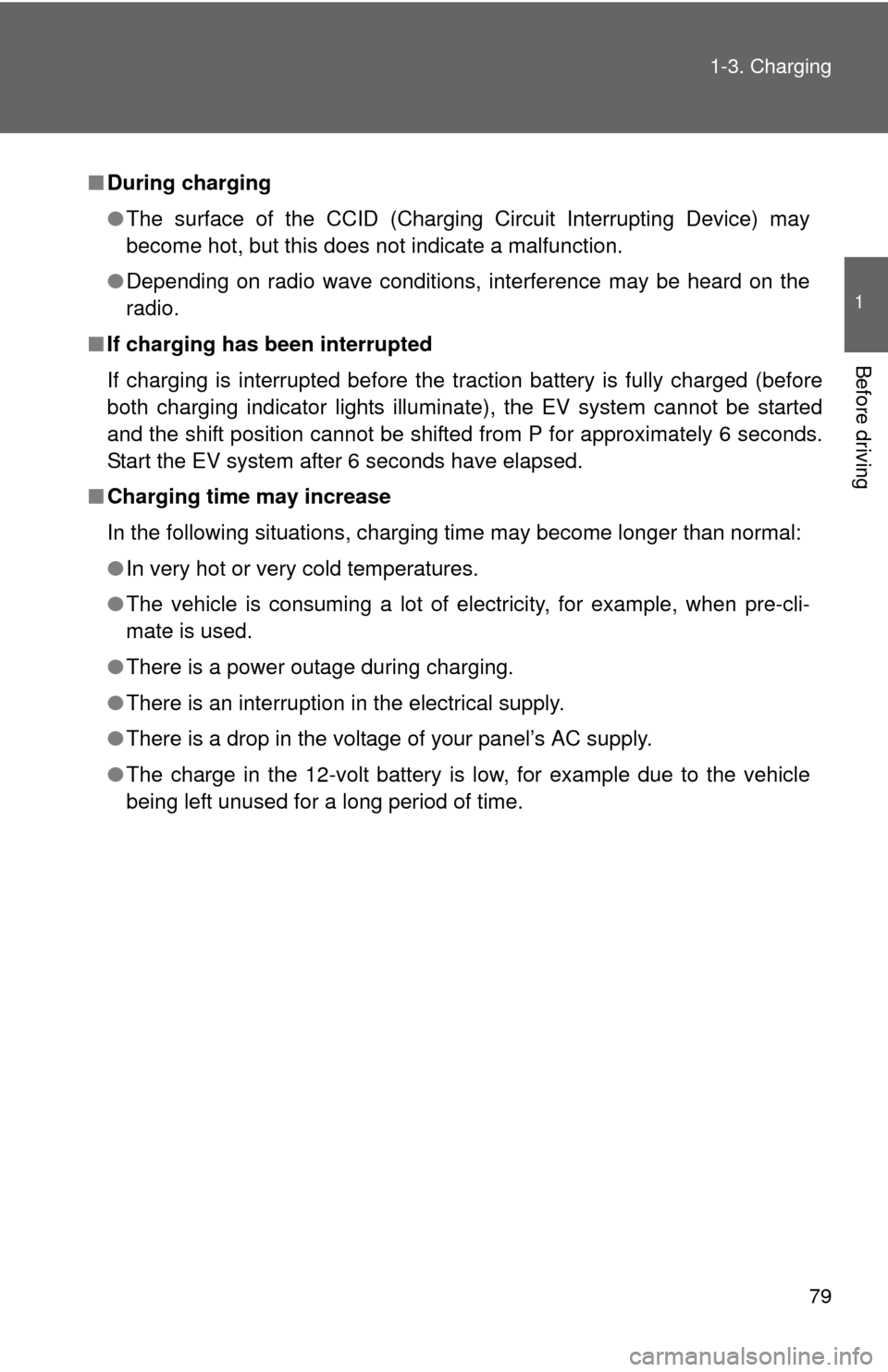
79
1-3. Charging
1
Before driving
■
During charging
●The surface of the CCID (Charging Circuit Interrupting Device) may
become hot, but this does not indicate a malfunction.
● Depending on radio wave conditions, interference may be heard on the
radio.
■ If charging has been interrupted
If charging is interrupted before the traction battery is fully charged (before
both charging indicator lights illuminate), the EV system cannot be started
and the shift position cannot be shifted from P for approximately 6 seconds.
Start the EV system after 6 seconds have elapsed.
■ Charging time may increase
In the following situations, charging time may become longer than normal:
●In very hot or very cold temperatures.
● The vehicle is consuming a lot of electricity, for example, when pre-cli-
mate is used.
● There is a power outage during charging.
● There is an interruption in the electrical supply.
● There is a drop in the voltage of your panel’s AC supply.
● The charge in the 12-volt battery is low, for example due to the vehicle
being left unused for a long period of time.
Page 80 of 521
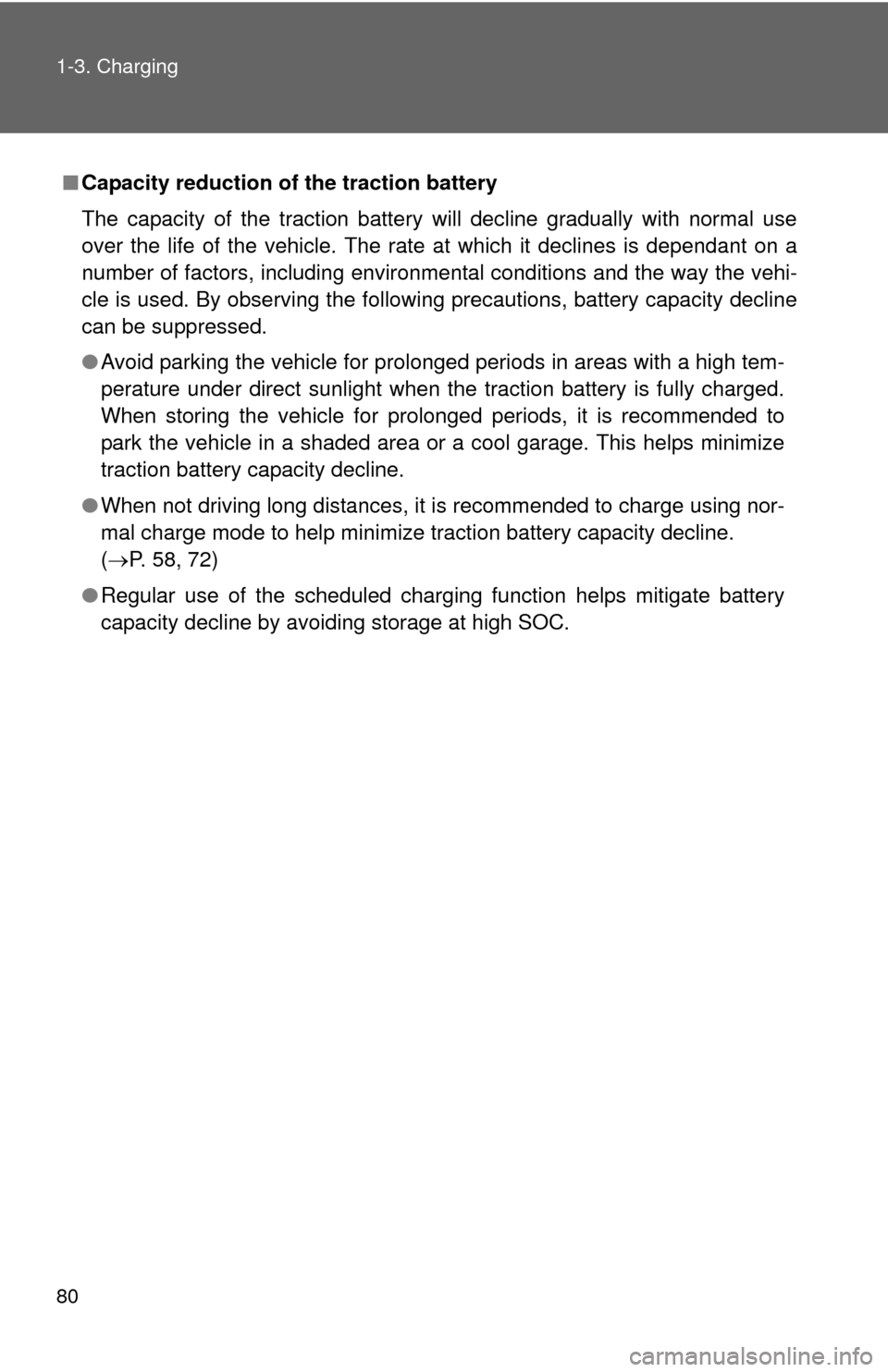
80 1-3. Charging
■Capacity reduction of the traction battery
The capacity of the traction battery will decline gradually with normal use
over the life of the vehicle. The rate at which it declines is dependant on a
number of factors, including environmental conditions and the way the vehi-
cle is used. By observing the following precautions, battery capacity decline
can be suppressed.
●Avoid parking the vehicle for prolonged periods in areas with a high tem-
perature under direct sunlight when the traction battery is fully charged.
When storing the vehicle for prolonged periods, it is recommended to
park the vehicle in a shaded area or a cool garage. This helps minimize
traction battery capacity decline.
● When not driving long distances, it is recommended to charge using nor-
mal charge mode to help minimize traction battery capacity decline.
( P. 58, 72)
● Regular use of the scheduled charging function helps mitigate battery
capacity decline by avoiding storage at high SOC.